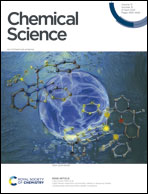Spatiotemporal dynamics of supramolecular polymers by in situ quantitative catalyst-free hydroamination†
Abstract
Implementing chemical reactivity into synthetic supramolecular polymers based on π-conjugated molecules has been of great interest to create functional materials with spatiotemporal dynamic properties. However, the development of an in situ chemical reaction within supramolecular polymers is still in its infancy, because one needs to design optimal π-conjugated monomers having excellent reactivity under mild conditions possibly without byproducts or a catalyst. Herein we report the synthesis of a supramolecular polymer based on ethynyl core-substituted naphthalenediimide (S-NDI2) molecules that react with various amines quantitatively in a nonpolar solvent, without a catalyst, at 298 K. Most interestingly, the in situ reaction of the S-NDI2 supramolecular polymer with a linear aliphatic diamine proceeded much faster than the homogeneous reaction of a monomeric naphthalenediimide with the same diamine, affording diamine-linked S-NDI2 oligomers and polymers. The acceleration of in situ hydroamination was presumably due to rapid intra-supramolecular cross-linking between ethynyl and amino groups fixed in close proximity within the supramolecular polymer. Such intra-supramolecular cross-linking did not occur efficiently with an incompatible diamine. The systematic kinetic studies of in situ catalyst-free hydroamination within supramolecular polymers provide us with a useful, facile and versatile tool kit for designing dynamic supramolecular polymeric materials based on electron-deficient π-conjugated monomers.



 Please wait while we load your content...
Please wait while we load your content...